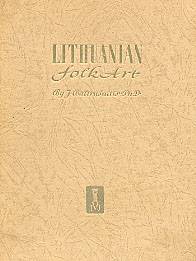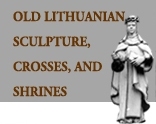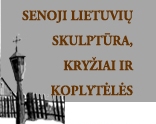JURGIS BALTRUSAITIS:
CROSSES AND
CHAPELS
Lithuanian Folk Art.
Germany, Munich, 1948. P. 36 - 54
But Lithuania is not only a
country of wooden churches: she is particularly the land of crosses.
Inseparable from the landscape their outlines follow the undulations of
the fields and penetrate into the woods. They are placed along the
roads, in the proximity of  sources,
on tombs, on piliakalniai, both in solitary and frequented
places. According to legend you find one at every ten paces in Holy
Žemaitija. At the cemetery of Vilnius they leave no room for a tree.
Though they are originally funereal they are mostly votive offerings.
They commemorate a birth, a baptism, the favorable issue of a lawsuit.
They are planted in times of epidemics or of drought. They remind the
peasant of the successes and misfortunes of his lifetime. Their
consecration was celebrated by ancient rites and banquets, at which mead
and beer flowed in streams. They often had nothing in common with a
cross but the name and the clergy forbade their use. As early as 1426
the church proscribed them. It refused to bless them and had them
removed from the neighbourhood of the chapels. Mr. Basanavicius has
proved that the origin of these monuments lies far back in primitive
beliefs. Trunks of trees, often rudimentary stems, were erected in
prehistoric cemeteries. The archives of the churches at Insterburg
testify to the custom followed by the Lithuanians up to the 17th century
of placing on their tombs figures carved from boards, horses for men and
birds for women. Up to the present day in the graveyards of fishermen in
the region of Klaipéda (Memel), one may come across toads and
fantastically shaped animals carved in oak or in pinewood. They are
placed not near the head, but at the feet of the dead. In these monsters
cowering on the grave, there is no trace of Christian symbolism. Though
their variety seems to be inexhaustible, - Mr. Varnas photographed more
than 2000 crosses all differing one from the other - these crosses and
steles may be divided into several groups. According to Mr. Galauné,
the most ancient type is a simple tree trunk rudely squared. Similar
funereal posts have also been found in Russia, in Finland and in
Hungary. At their tops there is sometimes a small roof and sometimes a
small niche. From these two archaic types stem two series of crosses:
the “mushroom cross”, crowned by a gable and the “lantern cross”,
consisting of a chapel supported by a pedestal. A third series comprises
the crosses properly so called. In these types of craftsmanship on a
reduced scale, rather than in churches and dwelling-houses, the
woodcutter gives his imagination free play to
sources,
on tombs, on piliakalniai, both in solitary and frequented
places. According to legend you find one at every ten paces in Holy
Žemaitija. At the cemetery of Vilnius they leave no room for a tree.
Though they are originally funereal they are mostly votive offerings.
They commemorate a birth, a baptism, the favorable issue of a lawsuit.
They are planted in times of epidemics or of drought. They remind the
peasant of the successes and misfortunes of his lifetime. Their
consecration was celebrated by ancient rites and banquets, at which mead
and beer flowed in streams. They often had nothing in common with a
cross but the name and the clergy forbade their use. As early as 1426
the church proscribed them. It refused to bless them and had them
removed from the neighbourhood of the chapels. Mr. Basanavicius has
proved that the origin of these monuments lies far back in primitive
beliefs. Trunks of trees, often rudimentary stems, were erected in
prehistoric cemeteries. The archives of the churches at Insterburg
testify to the custom followed by the Lithuanians up to the 17th century
of placing on their tombs figures carved from boards, horses for men and
birds for women. Up to the present day in the graveyards of fishermen in
the region of Klaipéda (Memel), one may come across toads and
fantastically shaped animals carved in oak or in pinewood. They are
placed not near the head, but at the feet of the dead. In these monsters
cowering on the grave, there is no trace of Christian symbolism. Though
their variety seems to be inexhaustible, - Mr. Varnas photographed more
than 2000 crosses all differing one from the other - these crosses and
steles may be divided into several groups. According to Mr. Galauné,
the most ancient type is a simple tree trunk rudely squared. Similar
funereal posts have also been found in Russia, in Finland and in
Hungary. At their tops there is sometimes a small roof and sometimes a
small niche. From these two archaic types stem two series of crosses:
the “mushroom cross”, crowned by a gable and the “lantern cross”,
consisting of a chapel supported by a pedestal. A third series comprises
the crosses properly so called. In these types of craftsmanship on a
reduced scale, rather than in churches and dwelling-houses, the
woodcutter gives his imagination free play to
produce complicated forms. The roof of the “mushroom cross” is
constantly renewed and reshaped as a cone or a pyramid, a star or a
Greek cross. Cornices are suspended below it. It is supported by
consoles or by twisted columns. They become reliquaries set on high
posts. Sometimes a number of such erections are placed one above the
other in the shape of strange pagodas. The “lantern type” goes
through a similar evolution, small houses replace the ordinary roof,
small klétis, the front of which is decorated with two columns,
buildings in the shape of a cross or a polygone with spires or small
central domes or rotundas. The walls are frequently replaced by pillars.
The chapel is often protected by trellis work, by jutty rooms, by
openwork balustrades, so that the chapel itself seems to be nearly
submerged under the weight of this light burden. It is an architecture
of fairy tales and toys. But it is the third group, that of crosses
proper, that is the fittest object of such goldsmith's work in boards.
It may be combined with the “lanterns”, and then the chapel is
placed at the crossing of the arms. In some cases the chapel disappears
completely, leaving nothing behind but its back wall, which then becomes
an independent element of ornamentation, a shield with capricious
outlines fixed at the intersection of the arms of the cross. One could
have thought that henceforth all traces of the ancient themes had
disappeared, but such is not the case. Around the cross, with or without
a chapel, there are often placed wheels and disks of fire. As in Ireland
there are frequently to be seen circles or fan shaped arrays of arrows,
leafwork, palm leaves, wreaths of flowers. Sometimes their dimensions do
not exceed those of a simple aureole, but in certain cases the cross is
submerged thereunder. To the now barely discernible Christian symbol
another element is joined, the origin of which goes back to pagan
traditions. It is a surviving remnant of prehistoric forms and of the
ancient worship of the celestial bodies. Sun wheels are revived and
eclipse the symbol of Christ. The myth is also preserved in the legends
transmitted by word of mouth. There can be no doubt that the most
ancient forms are those in which the wheel prevails. Sunk in the flames
of the former god, the emblem of the new religion is lost at first in
the conflagration and only emerges from it gradually. Gradually also the
light of the celestial body diminishes and transforms itself into an
aureole. For a long time both symbols are at par, but later the cross
emerges. It has often several arms, each of which itself bears several
arms. Finally the last of these accessories disappears and the cross
alone remains in its traditional simplicity. The large grave crosses
that stand inclined all over the open country belong to the most recent
type. Small votive chapels are scattered in the woods and in the
meadows. They only came into fashion at some later time and they are
especially frequent in Žemaitija. They shelter small statuettes and
offerings are usually deposited there, such als strings of beads of
amber or glass, ribbons, colored tissues, artificial flowers and
frequently also pocket mirrors, to which some particular meaning seems
to be attached. Small statuettes of the Holy Virgin are surrounded by
bits of looking glass, that reflect and multiply her image. Sometimes
such chapels are suspended aloft on trees, sometimes they stand on the
ground or on a base of stone. These are the cages or the cabins of the
Saints. The “cages” often attached to oaks, firs and pines, do not
differ essentially from the small “houses” set upon pillars and
crosses, but the ‘cabins” constitute a distinct series. They are
much larger, their height sometimes attaining two meters, they are no
longer toy houses and not yet real houses. Sometimes they consist of an
old excavated tree trunk, surmounted by a conical roof, the statuette
itself is placed in the very heart of the tree. They sometimes reproduce
the klétis type of church or its pyramid-shaped steeple, and
often they are built on a circular, hexagonal or octagonal plan. They
are easier to make on account of their reduced scale, which presents the
double effect of a church and piece of furniture. These monuments abound
in inventions, but they are not the work of ornamentalists like the
lanterns. The decorative elements of Western buildings are adapted to
them and the Gothic as well as the classic forms are reproduced there
according to the taste of the joiner. The small chapels are loaded with
spires and ornamental flowers. Broken arches run along the walls and
join the colonnades. The various themes are thrown into one and recast.
Out of this mixture arose a fantastic miniature architecture, a Pompeian
style of the Middle Ages, similar to that of the tabernacles and stained
glass windows of churches. Baroque designs treated with liberty and
measure are also frequent. Nothing is forgotten here, pinions, broken
gables, delicately outlined roofs and so on. Cornices, entablatures,
pillars, capitals and mouldings are carved with the greatest skill and
an eye for detail. Imaginary and real at the same time, these small
tempietti lost amid the vegetation, seem to have been devised to receive
the smaller deities of Nature. Similarly to the steles, crosses and
churches, these chapels are frequently surmounted with ornaments in
wrought iron. These appear later than the wooden solar roses, but
continue their tradition. Until the end of the 18th century they usually
represent the signs of celestial bodies, the sun, the crescent moon or
celestial wheels. Later the cross appears, but it is often broken up by
the geometrical ornamentations. Sometimes each arm bears supplementary
arms, sometimes the horizontal arms are double or even treble. Angels,
animals, persons and certain Oriental images are also represented. But
the design is always dominated by the theme of radiation. Arrows stream
forth in all directions, regularly undulated sword blades, idealized
vegetation, tulips which are already to be found on prehistoric jewelry,
the uruta, the national flower and branches of fir. When executed in
metal they retain all the hardness and refinement of the material of
which they are made. In these complicated networks all the parts are
cleverly united and cut with cold precision. The monuments are crowned
by iron crystals resembling blackened crystals of snow.

